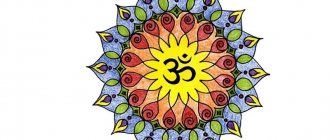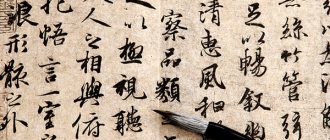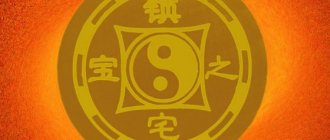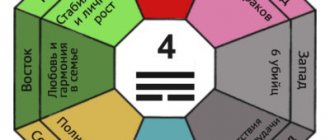Mantra (Sanskrit: मन्त्र) has three interpretations of literal translation:
- “an instrument for carrying out a mental act”;
- "liberation of the mind";
- “verse”, “spell”, “magic”;
It is a sacred text, word or syllable, the distinctive feature of which is the requirement for accurate sound reproduction.
For people who practice yoga, meditation, pranayama, this is a way of calming and relaxing through sound vibrations. There is an opinion that mantras help a person fulfill his desires, recover from illnesses, find love and various earthly blessings.
For every goal and desire there is a mantra:
Bija mantras.
Also known as “seed mantras”. They are a kind of prayers containing one or more sounds/syllables. As the masters say, bija mantras have greater power than all others, since they contain energy, the spiritual power of a particular Creator. It is for this reason that very often, in order to enhance the power of other mantras, syllables from the bija mantra are added to them;
Gayatri mantra. Written in Sanskrit, characterized by the poetic meter “gayatri”, consisting of 24 syllables. This is one of the most revered mantras, it is dedicated to Savitar (solar deity). According to mythology, Savitar made pilgrimages throughout the earth and through his bright light brought strength and longevity, and also drove out evil spirits. Legend has it that this deity transports the souls of the righteous with the help of his golden chariot;
Mahamrityumjaya mantra. It is believed that through repeated reading of this mantra, metabolic processes in the body are restored, the aging process is stopped and the human physical body is rejuvenated. Prescribed in difficult, sometimes even hopeless situations, it neutralizes the adverse effects of the planets, while healing, giving energy, self-confidence and spiritual strength;
Mantra Om. It is primary, it contributed to the creation of the entire universe. Helps to open one’s own energy channels, calm the mind and relax the body, clears the mind and thereby gives a person the opportunity to rise to the next stage of internal development;
Om Mani Padme Hum.
The sages believe that this mantra contains all eighty-four thousand teachings of the Buddha. It helps cleanse the body, speech and mind;
Om namah Shivaya.
Perhaps one of the most famous mantras in the whole world, it is considered universal, that is, it is used not only to fulfill a specific desire, but before any fateful event or for improvement in the daily practice of the spirit;
Panchabrahma mantra.
Consisting of six syllables, this mantra of the five faces of Shiva: Sadyojata (creation), Vamadeva (sustainment), Aghora (destruction), Tatpurusha (hidden mercy), Ishana (manifest mercy);
What are mantras
It is believed that humans first began to communicate with the universe through sounds and sets of phonemes more than 1000 BC. e. The ancient teaching made it possible to “tune in” to the cosmos. Correct vibrations helped remove resonance in life and restored harmony.
Previously, mantras were part of spiritual teachings. Later in India they began to be considered as a science. Today it is difficult to say unequivocally what it would be more correct to classify such communication with the Universe as. Although it is still considered mystical, many recognize that the right set of sounds has a practical effect on the body.
People describe the effect of mantras in different ways. Someone says that phonemes allow you to communicate with space, to see a solution to a problem, even if the situation was previously hopeless. Others are sure that it’s all about psychology - by mentally tuning in to change in life, a person on a subconscious level gains strength to carry out everything he has planned.
The word "mantra" is translated as "liberation of the mind." This description is the most accurate possible, because all rituals are aimed at working with awareness. It is believed that by choosing the right set of sounds for the situation, you can achieve anything, for example:
- to be healed from illnesses;
- find love;
- get a raise;
- correct the mistakes of the past;
- conceive a child;
- get rid of thoughts about the past;
- understand themselves.
By choosing the right set of sounds, you can find love.
Classification according to origin
Mantras are:
- Vedic. They are based on sacred texts from the Vedas using the names of deities. Suitable for people who want to practice independently.
- Tantric. They are often read with the aim of obtaining something material, to solve practical life problems. The practice involves performing rituals related to blood, sex, wine, and meat.
- Puranic. Compiled by wise men. "Purana" is translated as "history". Sanskrit texts talk about the historical past, but the Bhavishya Purana also talks about the future.
Types of mantras
You need to choose prayers depending on the situation. If some help cope with problems in the family, then others will be useless in this case. Therefore, before you start practicing, read about each type of mantra.
Saguna
Such a prayer is always addressed not only to the Universe, but also to deities (both one and several). The text must contain the name of the creature whose help you are asking for. Since mantras of this type are sacred, they must be pronounced as correctly as possible - higher powers may not forgive a person who has not tried to understand what he is reading.
Sagunas consist of 5 elements:
- Rishi. Translated it means “sage”. Thanks to him, texts appeared that he passed on to ordinary people.
- Bija. Gives power to sounds, allowing you to communicate with deities through words.
- Deity. A creature that helps turn desires into reality.
- Prophets. They are represented by any sacred beings to whom the request is made.
- Kilaka. A tool that allows you to lock up pure consciousness and not let destructive things into it.
Saguna is addressed to the deities, and not just to the Universe.
Nirguna
Such texts do not have an approved form. They are not personalized, not associated with the Gods. First of all, Nirguna is a prayer for practitioners who perceive the Universe as a single whole, i.e. without division into cultures and religions.
Abstract vibrations allow you to connect with higher consciousness, changing a person's thinking from the inside.
Bija
Monosyllabic sets of phonemes without semantic meaning. They help clear the mind and get rid of destructive things. The sounds are designed to activate the chakras in a specific sequence. Poems are a kind of massage that helps you relax, get rid of problems, and look at everything from a new angle. By removing blocks, a person will be able to find a way out of any life situation.
History of appearance
Sound energies have always existed. They were discovered thousands of years ago by ancient sages. During their meditations, they heard a repeating sound vibration. It could vary in power, sometimes being a manifestation of cosmic consciousness, and sometimes a correspondence to various natural phenomena.
The prophets wrote down mantras in the Vedas.
The prophets gave sounds the form of words and wrote them down in the Vedas. Over time, in Buddhism and Hinduism, mantras began to be called not only verses from this sacred book, but also other phrases that have an enlightening effect on the mind.
How mantras affect the human condition
By tuning into the right vibration, a person can change any aspect of his life. Poems help:
- relax;
- get rid of accumulated stress;
- open your mind to new people, things, thoughts;
- recharge your batteries;
- clear the mind of destructive attitudes;
- heal the body;
- renounce anger, sadness and envy;
- let go of the past.
By tuning into vibration, a person can renounce anger and sadness.
When they start to act
After the first 2 meditations, you may not notice any changes, because... the body and brain are still adapting to the new state.
What happens next depends on the goal:
- To calm your nerves or clear your mind before difficult work, 15 minutes of chanting a mantra will be enough.
- It will take about a month to notice the beneficial effects of prayer on your health.
- To change your destiny, you need at least six months of practice.
Spells begin to work from the very first meditation, but this is such an unobtrusive process that the degree of impact can be assessed only after some time.
Rules for pronouncing mantras
Since in sacred texts it is not the meaning of the words that is important, but their sound, it is important to pronounce each syllable correctly. Otherwise, practice will not bring the desired result.
General rules for reading mantras:
- Find a place where you can be alone. There should be no other people or pets in the room so that all vibrations come only from you.
- If possible, do not contact the Universe during the day. It is best to do this in the morning or evening, when you are as close to your nature as possible.
- Sit comfortably. Your body should not experience discomfort so that all the power of your mind can be directed towards reading the sacred texts.
- Breathe calmly. Take each breath deeply, letting streams of cosmic vibrations pass through you.
- Focus on what you are singing. Mantras will not have the intended effect if there is anything in your mind other than the reason you started the practice.
- Reach out to the Universe regularly. Changes do not happen in 1 day. It will take at least 1 year to get your life back on track. The effect of reading sacred texts will disappear as soon as you stop communicating with the higher consciousness.
Out loud
If you are just starting practice, you need to sing phonemes out loud. Pronounce all sounds clearly, creating vibration with the diaphragm. Watch the articulation: all syllables must be distinguishable. Also, do not forget about the duration: you cannot rush or pronounce phonemes too slowly.
Beginners need to sing the phonemes out loud.
Mantra in a whisper
When you have practiced reading mantras out loud and easily come into harmony with the Universe, you can move on to the second stage - singing sacred phonemes in a whisper. It is not necessary to make a sudden change in volume. If the transition is difficult, you can gradually begin to pronounce sounds more quietly.
Mentally
The final stage is silent practice. It will take more than 1 month to learn to reproduce the correct sound mentally.
However, having achieved such development, you will be able to practice mantras anywhere, regardless of time.
Energy connections and chakras
There are energy nodes in the human body - chakras. They represent the intersection of channels through which energy circulates. The meaning of the word is translated from Sanskrit as wheel or circle. With their help, energy is generated, released and absorbed, and also transformed.
There are 7 chakras in the body:
- Muladhara
- Svadhisthana
- Manipura
- Anahata
- Vishuddha
- Ajna
- Sahasrara
Each of them has its own color and location on the body and performs its own functions. The energy of these chakras can be in 3 states:
- Normal . Then as much energy is produced as is necessary for normal human life.
- Excited . In this case, more energy is generated than required. This manifests itself in restlessness and anxiety.
- Oppressed . There is not enough energy for life.
Chakras are human energy centers
In the first case, the energy of each of them separately and all together is in a balanced state. Excited or depressed states indicate an imbalance of one, several or all chakras at the same time. In most cases, an imbalance of 1 chakra leads to disruption of energy circulation throughout the body.
In this case, balance needs to be restored, and reading mantras is one way to do this.
How to practice mantras correctly
Before turning to space, learn the texts of the mantras. You can read from paper, but this will reduce the effectiveness of the practice.
It is not necessary to memorize all the verses at once: limit yourself to the basic sets of sounds.
What asanas to use
The canon is the lotus position. If you are just starting the practice and it is difficult to sit in the correct asana, take the most similar position. You can also access the Universe through:
- Vajrasana. To do this, kneel down and sit on your heels. Watch the position of your back - if you read mantras hunched over, you will not be able to create the right vibrations.
- Janashirshasan. Used by experienced practitioners. While singing, you need to constantly maintain balance, which makes it difficult for beginners to focus on connecting with the cosmos.
- Butterfly. A simple variation of the lotus, accessible even to those who read the mantra for the first time.
Practice rules
To use mantras correctly, you need to adhere to the following rules:
- Determining the right prayer. This is not so easy to do. But there is one that suits everyone - “Om-mani-padme-hum” . She has powerful positive energy.
- In order to pronounce sounds correctly, you must first listen to a recording with Russian subtitles, in which a person with clear diction reads the desired mantra.
- It is necessary to achieve a relaxed state, feel the circulation of energy throughout the body, and then mentally collect it in the head area. After this, you need to form a goal and start reading.
- Achieve the right mood: calm down, discard anxiety and negative thoughts. Concentration on the process should be maximum.
- You need to repeat the text 3, 9, 27, 54 or 108 times. The last number is the limit. It is not recommended to read them more than 108 times. This is done only in religious communities.
- It is not recommended to practice reading several prayers. It is better to stop at one, and after solving the issue, move on to the next one.
- At what time of day and in what position to sing depends on the person’s condition and mood. There are no clear rules here.
Mantras are endowed with great healing power
Which mantras to choose
Beginners rarely know what mantras are, so they choose only the most popular texts, such as “Om” and “Hare Krishna”. As you gain experience, you will learn that there are many prayers that can change your life:
- Ram. According to the canon, it is read in a low timbre, helps improve digestion, cleanse the chakras located in the abdominal area.
- Hum. Protects from negative influences from the outside. The text is associated with Shiva, who protects man from evil spirits. The mantra helps restore mental balance and energy spent on destructiveness.
- Shrim. Sounds addressed to Mahalakshmi contribute to professional and personal development. Text is closely related to creativity, so practicing such phonemes is useful for artists and actors.
Tips for Newbies
To achieve a good result, the text of the mantra must be pronounced accurately, for this:
- Choosing a suitable place where you can retire will infuse in the right way.
- Immediately before reading, meditate and visualize, imagining what you want.
- Select 1 suitable prayer.
- Keep your posture straight.
- The face should be facing east.
- Breathing is smooth and calm.
- Sounds must be pronounced in 1 key and drawn out.
- The reading number must be a multiple of 3.
- It is best to carry out this procedure at dawn, sunset or midday.
Safety precautions
Mantras should penetrate a person’s life gradually. If you overdo it, then either overwork and moral burnout will occur, or life will begin to change too quickly, chaotically, bringing trouble.
You need to work with mantras every day. First, 10-20 minutes, then increase this time to an hour. The body itself will tell you when you need to extend the practice - you will simply want to stay in a pleasant state of meditation a little longer.
It happens that the body does not keep up with the spiritual development of the soul. You will feel weak and apathetic. Physical activity will help maintain optimal balance. The more actively a person practices mantras, the more time he should devote to his body. In this case, it is enough to perform only feasible exercises - this could be sports, yoga, dancing or just regular walks.
Any sound has energy and power. Sometimes a person may feel the need to utter, for example, the word “happiness”, because as a result he feels uplifted and inspired. Such a deviation from the rules is permissible, but all the rules for pronouncing mantras apply to it.











